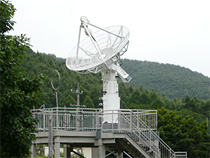
The mission of the Center for Space Science and Radio Engineering (SSRE) is to use the modeling and measurement of electromagnetic waves as the foundation of a deeper understanding of electromagnetic environments everywhere from space and the earth’s upper atmosphere to the places where we live our everyday lives.
Auroras are a well-known example of an electromagnetic phenomenon that occurs in a part of space that is relatively close to the earth. Auroras release light, which is a type of electromagnetic wave, and their characteristics can be understood through the use of optical observation equipment on the earth. Auroras have powerful electric currents flowing through their centers and peripheries, and these currents can be measured from satellites and the earth as magnetic field fluctuations. The area where auroras occur and powerful currents flow is known as the ionosphere. When high-frequency electromagnetic waves are emitted from the earth, they are reflected by the ionosphere. By using an antenna to observe these types of reflected waves, researchers at the Sugadaira Space Radio Observatory, which is one of the facilities of the center, are studying the dynamic properties of the ionized air in the ionosphere. By changing the wavelengths of the electromagnetic waves that are used, researchers can obtain information about the atmosphere far below the ionosphere, such as where lightning is occurring.
In this type of research, certain types of electromagnetic disturbances are understood to be valuable messages about natural phenomena and are being used to understand the nature of those phenomena. Meanwhile, electromagnetic disturbances also occur in the electric devices that are all around us, and these disturbances are a problem that directly affects our daily lives. Figuring out how to reduce the noise in device circuit boards is particularly important.
Our research is primarily focused on these types of electromagnetic phenomena and electromagnetic environment challenges. In the future, we will work to address new issues that transcend the boundaries of conventional research fields.

Since its founding in 1968, Sugadaira Space Radio Observatory has been researching terrestrial, planetary, and extraterrestrial electromagnetic environments using a variety of radio wave observation techniques. The observatory has a VHF and UHF satellite tracking receiver system, which is used to help with undergraduate specialized subject seminars.
Geographic coordinates (world geodetic system):36°32’ N 138°19’ E
Geomagnetic coordinates:27°12’ N 207°00’ E(June 1999)
Altitude:1,313m
You can visit this site to view current research projects, measurement data, and the like.